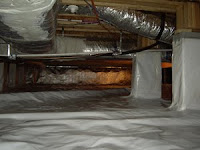The study has shown that during the summer of 2003, the studied sealed crawlspaces only exceeded 70% relative humidity only 5% of the time, while the vented crawlspace stayed above 70% almost all the time. The wood moisture content in the sealed crawlspace stayed below 12% during the study, while the vented crawlspace wood moisture varied greatly. Also, the sealed crawlspaces showed an annual energy use reduction of 15% for sealed crawlspace with insulation on the floors and 18% for sealed crawlspace with insulation on the foundation wall.
Here are some of the main benefits to having a sealed crawlspace:
1. Improved Moisture Control
A sealed crawlspace improves the moisture content of the space by preventing transfer of moisture through three of the main entrance points, the foundation wall, the soil floor, and the foundation vents.
2. Pest Control
By removing moisture from the space, the appeal to subterranean termites is reduced.
3. Improved Efficiency
As already stated from the study, results a sealed crawlspace can improve the efficiency of the home.
4. Improved Indoor Air Quality
A good number of contaminates can come from your crawlspace. By cleaning up the space, you may be able to improve the air quality of your home. A sealed space can reduce the mold content in the crawlspace and can be used or modified to prevent radon intrusion.
5. Improved Maintenance
This is an unintended benefit, but due to the increased visibility and improved environment, homeowners are more likely to “visit” the space, leading to better home maintenance. Also, if the insulation is installed on the walls, the floor structure is visible and individuals are more likely to find problems around plumbing or HVAC.
Increase your ceiling insulation.
Most of your heat loss is through the ceiling of your home; by adding insulation in the attic, you can save energy. Insulation in the attic is relatively easy to install when compared to insulation in other areas, and it can have a greater impact. Here in North Carolina, we are required to have R-30 insulation in the ceilings, but I can see a benefit by increasing this to R-38 or beyond. Be careful, though - there will come a point in which the cost of the additional insulation will not outweigh the benefit of installation!
Technorati: TRARQRDRRVDN






No comments:
Post a Comment